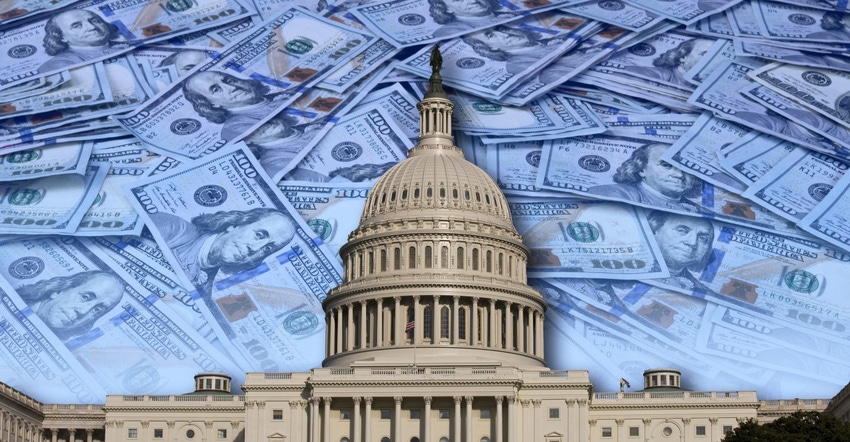
This week Secretary of Agriculture Tom Vilsack announced that within the spending authority of the Commodity Credit Corporation, the agency had enough funds to not only pay for the normal farm bill programs which are normally paid out of the CCC, but also use CCC funds to increase USDA’s commitment to climate-smart agriculture, nearly tripling the previously announced investment of $1 billion to $3.5 billion for new pilot projects.
In case you’ve heard of the CCC, but not really understood how it functions, it acts similar to a credit card that is always paid off by the federal government. Essentially, the CCC funds mandatory farm bill programs, such as ARC and PLC, as well as conservation programs and foreign international food aid assistance programs including Food for Peace.
The CCC has permanent indefinite authority to borrow up to $30 billion from the Treasury to finance these Congressionally-authorized programs. Every year, as part of the appropriations process, Congress reimburses the CCC for its "borrowing" or the reimbursement of net realized losses, effectively making the $30 billion a cap on spending for programs under the CCC’s jurisdiction.
With this week’s new boost to a key Biden administration priority of mitigating climate, Rep. Glenn “GT” Thompson, of Pennsylvania and leading Republican on the House Agriculture Committee, questioned if Congress has been removed from its role in helping guide how funds are targeted to support rural America within the selection by USDA of 70 projects to receive the pool of $2.8 billion in the first round of pilot projects.
"The Biden Administration is unilaterally spending billions of dollars without Congressional input,” Thompson notes. “While I am sure there are worthy projects, USDA is abusing the authorities of the Commodity Credit Corporation to stand up a 'pilot program' while ignoring the significant issues facing farmers and ranchers.”
Vilsack isn’t new to criticism from those on Capitol Hill for pulling the purse strings on CCC funds. In 2010 the Obama Administration directed $630 million in assistance to farmers in Arkansas, which was later viewed to help secure the reelection of Senate Agriculture Committee Chair Blanche Lincoln, D-Ark. (Who actually lost that election, despite the money funneled to her district.)
In 2015, Vilsack used the CCC to spend $100 million to pay for new gas station blender pumps to boost the utilization of biofuels that the 2014 Farm Bill prohibited. In a reversal of roles, the issue of CCC authority and congressional intent was raised again in early 2016 when USDA announced that it was denying the cotton industry’s request to provide subsidies for cottonseed.
From fiscal years 2012 until 2017, Congress through the appropriations process limited the USDA secretary from politicizing USDA’s credit card.
Fast forward a few years, and Congress lifted the restrictions for USDA so the agency could help cotton farmers who were faced and needed support through a cotton gin cost-share program. Although the program was finalized in 2018, it was actually during hearings when Vilsack was still in the Obama administration that he asked for Congress to loosen his restrictions so he could help cotton producers struggling from a market concerns in 2016. (Read more on the history of the CCC program here.)
Trump administration ran up taxpayer costs too
But this isn’t just an issue for Democrat administrations. During the Trump administration, the USDA under the direction of former Secretary Sonny Perdue, got creative with the credit line to dole out Market Facilitation Program (MFP) trade mitigation payments and Coronavirus Food Assistance Program payments under the Trump administration.
In a fact sheet about the CCC published by Taxpayers for Common Sense, it notes the deliberate shift of the farm safety net away from reliance on direct government subsidies and toward risk management (subsidized crop insurance) has made the $30 billion annual limit, set by law since 1987, effectively moot.
Over the last three farm bills (2008, 2014, 2018) the only year total borrowing approached the limit was in 2019, mostly due to unbudgeted ad hoc payments of $28 billion made under the Trump administration's programs to mitigate the damage from its trade war. Total borrowing for 2020 is expected to be nearly $45 billion, with additional spending made possible by an early reimbursement of $14 billion in net realized losses in the CARES Act.
“Any debate about expanding the farm safety net should be done through the farm bill because there are likely to be more voices at the table. As was shown through the USDA-created Market Facilitation Program (MFP) and the Coronavirus Food Assistance Program (CFAP), executive action is heavily biased toward special interests and large operations at the expense of taxpayers and small operations,” according to Joshua Sewell, senior policy analyst for the Taxpayers for Common Sense.
The actions by the Trump administration’s USDA empowered the current administration’s USDA to creatively use the agency’s CCC authority to circumvent Congressional input. In his justification for the additional money for climate-smart projects, Vilsack says the over 1,050 applications from every state, all commodity groups and hundreds of universities reflects the support for USDA utilizing CCC funds for learning more about climate-smart commodities.
“This is different than the previous administration that basically drained the CCC, and Congress had to come in and nominally and refill the CCC early,” Vilsack says.
But as Thompson questioned, is this truly the best use of CCC funds, aka taxpayers’ money, to prop up a key priority favored by this administration.
“It’s as though Secretary Vilsack is intent on having Congress once again limit his ability to use the CCC," Thompson says.
About the Author(s)
You May Also Like






